Case 2: How do cancer cells spread throughout the body?
CASE 2 cancer: when good cells go bad
Nonmalignant, or benign, tumors are encapsulated masses of cells that divide continuously because regulation of cell division has gone awry (Chapter 11). As the tumor grows, its border pushes outward against adjacent tissues. Benign tumors are rarely life threatening unless the tumor interferes with the function of a vital organ.
Malignant tumors are more dangerous. They contain some cells that can metastasize, that is, break away from the main tumor and colonize distant sites in the body. Metastatic tumor cells have an enhanced ability to adhere to extracellular matrix proteins, especially those in the basal lamina. This is significant because for a cell to metastasize, it must enter and leave the bloodstream through capillaries or other vessels. Since all blood vessels, including capillaries, have a basal lamina, a metastatic tumor cell needs to cross a basal lamina at least twice—

214
In some types of cancer, the number of specific integrins on the cell surface is an indicator of metastatic potential. Melanoma provides an example. A specific type of integrin is present in high amounts on metastatic melanoma cells but is absent on non-